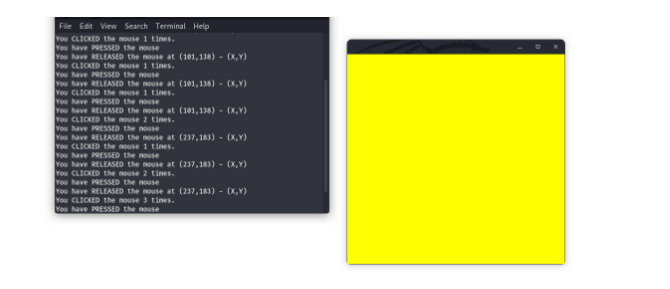
Java allows developers to listen for occasions from a mouse (or a comparable gadget, such as a touchpad). There are 3 various user interfaces that designers can carry out for various actions from a mouse input. These user interfaces are separated in this way since tracking the mouse’s movement utilizes more system resources than other mouse occasions. In this shows tutorial, we will discover how to carry out different mouse occasion listeners in your visual Java applications.
Prior to we start, you might wish to review your occasion listening abilities. If so, we have an excellent guide to dealing with Java Occasion Listeners you ought to have a look at.
What is a Mouse Listener in Java?
In Java, the MouseListener user interface signs up an occasion whenever the mouse cursor is moved into the location of an element listening for mouse occasions. To include this listener to an element, designers can utilize the addMouseListener( instanceOfHandler) approach.
MouseListener has 5 approaches developers can utilize to identify when the mouse:
- Has actually been clicked: mouseClicked( MouseEvent e)
- Has actually been pushed: mousePressed( MouseEvent e)
- Has actually been launched: mouseReleased( MouseEvent e)
- Has got in the part area: mouseEntered( MouseEvent e)
- Has left the part area: mouseExited( MouseEvent e)
The example code listed below demonstrate how to use each of these 5 MouseListener approaches:
import javax.swing. *;
. import java.awt. *;
.
import java.awt.event. *;
.
.
. public class MouseListenerHandler executes MouseListener {
.
.
. JFrame frame= brand-new JFrame()
;
. Container pane= frame.getContentPane
();
.
.
.
MouseListenerHandler() {
.
pane.addMouseListener( this);
.
.
. frame.setDefaultCloseOperation( JFrame.EXIT _ ON_CLOSE
)
;
. frame.setSize( 375,450);
.
frame.setLocationRelativeTo( null
);
. frame.setVisible( real );
.}
.
.
.
public space mouseClicked( MouseEvent e) {
.
.
.
int x= e.getClickCount();
.
System.out.println(" You CLICKED the mouse" +x+" times.
"
);
.}
.
.
.
public space mouseEntered( MouseEvent e) {
. pane.setBackground( Color.YELLOW);
.}
.
.
.
public space mouseExited( MouseEvent e) {
.
pane.setBackground(
Color.MAGENTA);
.}
.
.
. public space mousePressed (MouseEvent e ){
. System.out.println(" You have actually pushed the mouse");
.}
.
.
. public space mouseReleased( MouseEvent e) {
.
.
.
int a= e.getX();
. int b= e.getY( );
. System.out.println(" You have actually launched the mouse at (" + a +", "+ b +")-( X, Y)" );
.}
.
. public fixed space primary( String args[]) {
.
. brand-new MouseListenerHandler ();
.
.}
.}
.
Running this code in your code editor or incorporated advancement environment (IDE) produces the list below output:

Read: Leading Performance Tools for Java Developers
Java Mouse-Motion Listener
The MouseMotionListener user interface enables designers to keep an eye on the cursor motions made by the mouse. It has 2 approaches which can allow you to understand when a user has:
- Pushed and dragged the mouse: mouseDragged (MouseEvent e)(* )Moved the mouse with pushing it:
- mouseMoved( MouseEvent e) The example Java code listed below prints out a message on your terminal whenever a user makes any of the above actions:
import javax.swing. *;
.
import java.awt. *;
. import java.awt.event. *;
.
.
. public class MotionHandler extends JPanel executes
MouseMotionListener {
.
.
. JFrame frame
=
brand-new JFrame();
. Container pane= frame.getContentPane
(
)
;
.
. MotionHandler() {
.
pane.addMouseMotionListener( this);
.
.
. frame.setDefaultCloseOperation( JFrame.EXIT _ ON_CLOSE
)
;
. frame.setSize( 400,450);
. frame.setLocationRelativeTo( null);
.
frame.setVisible( real);
.}
.
. public space mouseDragged( MouseEvent e) {
.
System.out.println( “You have actually DRAGGED the mouse”);
.
}
.
.
.
public space mouseMoved( MouseEvent e) {
. System.out.println( “You have MOVED the mouse”);
.}
.
.
. public fixed space primary( String args
) {
. brand-new MotionHandler();
.
.}
.}
.[] Java Mouse-Wheel Listener
In Java, the
MouseWheelListener is a user interface utilized to listen for the rotation of the mouse wheel. Prior to going any even more, it is very important to keep in mind that not all mouse-like input gadgets offer mouse-wheel rotations. The
MouseWheelListener has just one approach: mouseWheelMoved( MouseWheelEvent e ) Designers can utilize this approach to carry out some reasoning like informing which instructions the mouse wheel has actually been moved and by just how much. The
MouseWheelEvent class has some beneficial approaches that can offer developers info about the rotations. A few of those approaches consist of: getWheelRotation()
- : returns an integer variety of clicks for the mouse rotation getPreciseWheelRotation()
- : returns a double-precision worth for the clicks of a mouse rotation. This can be essential for when insufficient rotations are made You can discover the total list of mouse listener approaches from the authorities
Oracle API docs for Java. The code example listed below prints out the variety of clicks for the mouse rotation in the visual part for which you are listening for mouse occasions (in this case the panel of the
JFrame). If you attempt turning the mouse-wheel both forwards and in reverse, you will discover that favorable and unfavorable worths are produced for each of the matching instructions. Here is the code:
import javax.swing. *;
. import java.awt. *;
.
import java.awt.event.
*;
.
.
. public class MouseWheelHandler executes MouseWheelListener {
.
.
. JFrame frame= brand-new
JFrame();
. Container pane = frame.getContentPane();
.
.
. MouseWheelHandler() {
. pane.addMouseWheelListener( this);
.
.
. frame.setDefaultCloseOperation( JFrame.EXIT _ ON_CLOSE);
. frame.setSize( 390,450);
. frame.setLocationRelativeTo( null);
. frame.setVisible( real);
.}
.
.
. public space mouseWheelMoved( MouseWheelEvent e) {
. System.out.println( e.getWheelRotation());
.
}
.
. public fixed space primary( String args
) {
.
. brand-new MouseWheelHandler();
.
.
}
.
}
.[] Last Ideas on Java Mouse Listeners
In this Java shows tutorial, we discovered that mouse occasions can be caught from a mouse or a comparable input gadget. There are 3 various mouse listeners that developers can utilize for mouse occasions, that include:
MouseListeners, MouseMotionListener, and MouseWheelListener Keep in mind, too, that the MouseWheelListener might operate in a different way depending upon the user’s input gadget. Check Out: